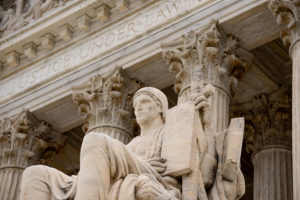
Recent Supreme Court redistricting decisions clarify two important legal developments—but leave the status of partisan gerrymandering claims unresolved.
Redistricting cases have long had a prominent place on the Supreme Court’s docket. This past session was no exception. The recently completed 2015–2016 term saw no less than four published opinions on the subject.
Arizona has had two redistricting cases before the Supreme Court in the last two years. In Arizona State Legislature v. Arizona Independent Redistricting, decided last year, the Court upheld the independent commission that Arizona voters adopted in 2000 to draw district lines in the state. This year, in Harris v. Arizona Independent Redistricting Commission, the Court rejected a malapportionment challenge to Arizona’s state legislative districts.
Harris lies at the intersection of two important developments in the law of redistricting: the use of independent commissions to draw district lines in some states, and the refinement of the one person, one vote rule by the Supreme Court. A brief look at the history of redistricting is vital to understanding Harris’s significance and the bigger questions it implicates, most importantly partisan gerrymandering.
Gerrymanding is the drawing of district lines to favor a political party or other interest. The practice is almost as old as the Republic itself. The term derives from state senate districts that were approved in 1812 by then-Massachusetts Governor Elbridge Gerry.
For most of this country’s history, the federal courts stayed out of redistricting, viewing it as a political question best reserved for the other branches of government. The idea, as Justice Felix Frankfurter famously stated, was that courts ought to stay out of the “political thicket.” He and other justices thought that once courts got into the business of policing how district lines are drawn, they might never leave. Some would argue that subsequent developments proved Justice Frankfurter right.
In the 1960s, the Court reversed course and entered the political thicket, first in Baker v. Carr, which declared that the courts could entertain malapportionment claims, and then in Reynolds v. Sims and other cases that created the one-person, one-vote rule. Malapportionment refers to districts of unequal populations that have the same representation. For example, in Alabama—which is where Reynolds emerged—the largest state legislative district had over 40 times more people than the smallest district. This malapportionment was due to population shifts over the course of the twentieth century, especially the migration from rural to urban areas. The result was the underrepresentation of cities—to which, not coincidentally, many African Americans had moved—and the overrepresentation of rural areas.
Reynolds and other one-person, one-vote cases struck down the malapportionment of legislative bodies, holding that districts must be drawn on an equal-population basis. The immediate result was the imposition of a requirement that legislative districts across the country be withdrawn. The ongoing consequence was that every state had to redraw its district every decade after the census to account for population shifts.
The one-person, one-vote rule is now over a half-century old, so one might expect that all of the big issues about its implementation would have been settled years ago. Not so. Harris clarifies a question that has long been shrouded in uncertainty: exactly how close to population equality do state legislative districts need to be?
For a long time after Reynolds, it was presumed that there existed a safe harbor for state redistricting plans that have a total maximum deviation—that is, a deviation between the most and least populated districts—of under 10 percent. The Supreme Court disrupted that presumption in 2004. In Cox v. Larios, the Court which summarily affirmed a lower court ruling that struck down a plan with a total deviation of 9.9 percent. There was evidence in Larios that the deviation was motivated by partisan considerations, specifically a desire to help Democrats.
The Harris plaintiffs argued that something similar was going on in Arizona. The state’s legislative districts were drawn by the Arizona Independent Redistricting Commission, consisting of two Democrats, two Republicans, and a fifth member who was unaffiliated with either party. This commission was created to avoid the problems associated with partisan entities like state legislatures drawing lines.
The Redistricting Commission drew a plan with an 8.8 percent total maximum deviation, but the plan systematically underpopulated Democratic districts and overpopulated Republican districts. Plaintiffs argued that the plan effectively disadvantaged Republicans whose votes were allegedly diluted. The plan was approved by the two Democratic commissioners and the unaffiliated commissioner. The two Republican commissioners voted against it.
The Commission defended this plan on the ground that the deviations were necessary to comply with Section 5 of the Voting Rights Act, which covered Arizona at the time the districts were drawn. The Supreme Court accepted this explanation, while clarifying the legal standard that applies to state redistricting plans that have minor deviations from population equality.
Justice Stephen Breyer’s opinion for a unanimous Court stated that plans with a total maximum deviation under 10 percent do not ordinarily require a special justification. Rather, the burden is on “those attacking a state-approved plan [to] show that it is more probable than not that a deviation of less than 10 percent reflects the predominance of illegitimate reapportionment factors rather than the ‘legitimate considerations.’” Legitimate considerations include traditional redistricting criteria like compactness, contiguity, and the preservation of political subdivisions.
The Harris Court found insufficient evidentiary support for plaintiffs’ argument that Arizona’s deviation from population equality was motivated by partisanship. The Court assumed without deciding that partisanship would be an illegitimate consideration, but found that the Commission’s predominant motivation was to comply with the Voting Rights Act, not to help Democrats. Specifically, the Commission was trying to draw 10 districts from which racial minorities could elect their candidates of choice.
The Harris opinion thus clarifies one person, one vote law, giving independent commissions and other line-drawers some degree of discretion in drawing districts. So long as the total deviation is under 10 percent, plaintiffs must prove that an illegitimate factor predominated in order to show a constitutional violation.
On the other hand, Harris does not completely shut the door to claims that minor deviations are unconstitutional. If plaintiffs can show that the primary motivation for the deviation was to benefit the state’s dominant political party, then they may be able to prove a constitutional violation. This kind of claim is more likely to succeed when a partisan body like a state legislature draws districts—the norm in most states—than when an independent commission draws the lines, as in Arizona.
The big issue Harris leaves unresolved is the status of partisan gerrymandering claims. It is often possible to draw a plan that strongly advantages one of the major parties, while keeping population deviations to a minimum. For years, the Court has been splintered over the question of whether it should entertain partisan gerrymandering claims.
With the death of Justice Antonin Scalia, who staunchly opposed recognition of freestanding partisan gerrymandering claims, the issue of partisan gerrymandering is again up for grabs. It thus remains to be seen whether the Supreme Court will dive even deeper into the political thicket, or defer to those who draw the lines to promote their own political advantage.
This essay is part of The Regulatory Review’s seven-part series, The Supreme Court’s 2015 Regulatory Term.




